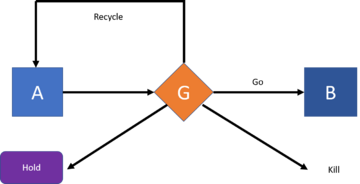Stage-Gate Process
Contents |
Abstract
The Stage-Gate Process (also referred to as Phase-Gate Process) is a project management tool, dividing the time horizon of a project into several information-gathering stages. These stages are separated by so-called gates, which represent go/kill/recycle decisions for the project. The concept was introduced by Cooper (1986) in his book 'Winning At New Products'[1].
The central background of the Stage-Gate Process is rooted in the fact that companies have limited resources (e.g. time, money & capital goods). To make effective use of the available resources and to manage risks, a firm has to develop its project portfolio in a manner that only the most promising/beneficial projects are put through. Regular Stage-Gate Processes include 4 to 8 stages, which can be conducted in parallel or can be skipped depending on the preferences of the company [2][3]. The evaluation criteria at each gate are discussed upfront with the project group and are acted upon by the gatekeeper during a gate meeting. Each gate decision should be a objective process; anybody in the organization should come to the same conclusion.
A Stage-Gate Process is complementary to project evaluation methods that, for example, analyze resource availability, project-related risks or costs and benefits of the project. The method is also frequently used in combination with other project management tools, like Gantt Charts or Concurrent Engineering theory [4] The process can be used in most project-related contexts, but gained a lot attention in the field of new product development as a strategic pacing method [5]
Basic Elements of the Stage-Gate Process
The basic idea of a Stage-Gate Process is that the whole project is divided in a predetermined set of stages. These stages consist of groups of related activities that end in so-called gates. Gates are characterized as containing a set of deliverables or inputs, a set of criteria, and an output [6].
Stages
Stages often consist of activities that roughly follow the same trajectory, where first the data is collected, integrated and analysed[3].
Cooper (2008) mentions several key characteristics that need to be taken into account when identifying stages[7]:
1. Each stage should strive to reduce key project uncertainties and risks. For the stage information requirements guide the team in their way-of-working.
2. Each stage is more costly than the preceding one, but risks and uncertainties are lower.
3. Activities within stages are undertaken in parallel and by a team of people from different backgrounds
4. Each stage is cross-functional; so no departmental focuses are present
Gates
Where stages represent a longer period of time (weeks or months); gates represent meetings with a time-span of several hours. At each gate the following elements are relevant to keep in mind [6]:
Inputs/Deliverables: the deliverables that the project leader must bring to the gate
Criteria: which are the items upon the input will be judged.
Outputs: the decisions at the gate, and possible the approval of an action plan for the next stage
Senior managers man the gates, and act as so-called gatekeepers. This group is diverse in nature and each member has the power to approve the resources needed for continuation of the project [6].
During the gate meeting the gatekeepers meet to discuss the future of a project. The objective decision they make is fully based at the ability of the team to meet the gate criteria. The following outputs can be generated during the gate meeting:
1. Go: here the input created by the project team is sufficient. The next step is to proceed with the next stage.
2. Kill: here the input created by the project team is insufficient or the result imply that the project will not be able to yield the desired benefits. The next step is to terminate the project, and review the process.
3. Recycle: here the input created by the project team is insufficient, but the project still has potential to yield benefits. The next step is to restart the current stage, and update the inputs.
4. Hold: here the input created by the project team may be sufficient or insufficient. The gatekeepers decide to delay their decision, and wait until inputs of parallel processes are provided at the next gate. Based on the input of these processes a decision will be made about continuing, stopping or recycling the project.
Application areas for the Stage-Gate Process
Possible theoretical synergies
Limitations of Using the Stage-Gate Process
References
- ↑ Cooper, R.G. (1986). Winning At New Products. Addison-Wesley, ISBN 0201136651
- ↑ O'Connor, P. (1994). From Experience; Implementing Stage-Gate Process: A Multi-Company Perspective. Journal of Product innovation Management. Vol 11. pp 183-200
- ↑ 3.0 3.1 Cooper, R.G. (2008). Perspective: The Stage-Gate Idea-to-Launch Process — Update What’s New, and NexGen Systems, Product Development & Management Association, Journal of Product Innovation Management. Vol. 25. pp 213–232
- ↑ Thamhain, H. (1996). Applying stage-gate processes in concurrent engineering. Wescon/96. pp 2-7
- ↑ Sharma, A. (1999). Central Dilemmas In Managing Innovation in Large Firms. California Management Review. Vol 41. No 3. pp 146-164
- ↑ 6.0 6.1 6.2 Cooper, R.G. (1990). Stage-Gate Systems: A New Tool for Managing New Products. Business Horizons. pp 44-54
- ↑ Cooper, R.G. (2008b). Perspective: The Stage-Gate Idea-to-Launch Process — Update What’s New, and NexGen Systems, Product Development & Management Association, Journal of Product Innovation Management. Vol. 25. pp 215
